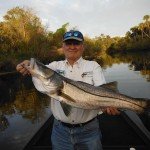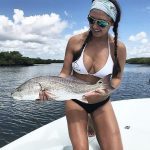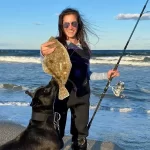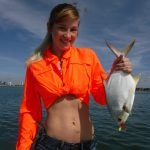13 Effective Saltwater Flats Fishing Tips!
This article will thoroughly list 13 effective flats fishing tips. Flats are often very good fishing spots. The main reason for this is that flats provide the perfect environment for the forage that game fish feed on. Flats almost always have vegetation of some type along with other cover. This attracts the prey that larger fish feed on.
A flat will be defined as a large area of similar depth surrounded by deeper water. Flats can be found in water of any depth. However, flats that are 15 feet deep or shallower are generally the most productive.
Capt. Jim Klopfer has been a fishing guide in Sarasota, Florida since 1991. He spends the majority of his time Flats fishing. He also grew up in Maryland fishing Chesapeake Bay. Capt. Jim has also fished the flats in the Bahamas and other parts of the country. He is sharing his 40 years of Flats fishing experience in this article.

While most anglers associate flats fishing with saltwater angling, those fishing in freshwater will find that many of these techniques apply to them as well. The primary difference will be that and saltwater fishing tidal flow affects the water height daily while in freshwater lakes water levels change at a much more gradual rate. While this article will focus mostly on the eastern part of the United States, the techniques and strategies will work anywhere in the world.
1) Saltwater flats fishing techniques
There are really two different types of flats; shallow water flats and deep water flats. Shallow water flats are ruled by the tides. Water height and current flow are critical when fishing the flats in shallow water. Depending on the area of the country the angler is fishing, the tide range can be from as little as 1 foot along the Gulf Coast to over 10 feet in the Northeast. That is a lot of water that is moving in a six-hour period!

Deep water flats are affected by the tide, but to a lesser degree. The biggest distinction is that at low tide there will still be plenty of water for fish to move about and feed freely. Some of the best fishing and angler will experience can occur on these deeper flats. Fish will be more comfortable in this deeper water and large schools of fish are often encountered.
2) Flats fishing in shallow water
As mentioned above, understanding how tides affect the flats and fish movements are critical to success. So, the entire tide cycle will be described below.

On the low tides, fish will stage in deeper water. This is a necessity as often times there simply is not enough water on the shallow flats for them to move about freely. These deeper spots can be holes or troughs within the flat itself. Also, fish will stage in the deeper water on the edges of flats, waiting for the tide to come in so that they can move up on the flats to feed.
This can be an outstanding time to fish! Both single fish and schools of fish will be concentrated in these deeper areas. Anglers who find these holes can experience fast action if they can get to them. These are often called “potholes” and will hold a surprising number of fish. This especially happens in the winter on the extreme low tides.

As the tide comes in, fish will move up out of these deeper areas and begin to feed. Fish that are staged in deeper water on the outside of the flat will often cruise the edge of the flat waiting for the water to come up enough so that they can swim up on the flat. Once again, this concentrates fish and makes them easier to locate. Also, these fish are relatively easy to catch as they are in the mood to eat.
3) Flats fishing is very good on the low, incoming tide
These fish on the low, incoming tide are often the best to target. They have been waiting for the tide to come in in order to feed. Also, even if these fish since the angler’s presence and spook, they will usually return and become aggressive again after a little time to settle down.

As the tide rises and pushes to high tide, fish will scatter out on the flat. While they are still in a feeding mood, they are much more difficult to locate as there is simply a lot more water where they may be. However, anglers can still do well using search baits that cover a lot of water quickly. By high tide fish may be way back in the flat up under trees or in thick vegetation. They can be difficult to catch at this time.
As the tide turns and begins to ebb out, fish will move out of these extreme areas and back towards deeper water of some sort. They innately understand that if bass they too long on the flat, they will run out of water. These fish are usually a bit harder to catch for a couple of reasons. Most have been feeding fairly heavily on the incoming tide. Also, once spooked on the shallow water flats, fish will often times vacate the flat and not come back.

Feeder creeks and channels that drain flats are prime times to fish on the outgoing tide. Much like fish in freshwater rivers, game fish will take up ambush points at spots where the tide flow will bring food to them. Any type of cover such as oyster bars, vegetation, or boat docks will increase the chances of success. As the tide approaches low, fish will move back into the deeper areas once again in the cycle will repeat itself.
4) Flats fishing with lures
Most anglers Flats fishing in shallow water do so using artificial lures. There are a couple of reasons for this. Lures allow anglers to cover water much more quickly than they can using live bait. Artificial lures are also more effective often times in shallow water, especially if grass or vegetation is present. Finally, anglers flats fishing with lures do not need to deal with the hassle of procuring or keeping alive live bait.

The three most effective flats fishing lures are jigs and soft plastics, spoons, and plugs. Jigs and other soft plastic fishing lures are the most popular choice as a are versatile, effective, and fairly economical. Light jig heads are used in shallow water. Many have a specially designed head that is curved and allows them to move over and through the grass better without hanging up. 1/8 ounce is a good all-around size.
Anglers can then adorn the jig with their soft plastic bait of choice. The selection is endless, with most of them catching fish if presented properly. A 4 inch shad tail bait or 5 inch jerk bait are both good choices. Capt. Jim likes the Bass Assassin 4” Sea Shad swim bait and the 5” Gulp Jerk Shad jerk bait.
Read Capt Jim’s article on saltwater fishing tackle
Spoons are extremely effective flats fishing lures. Anglers have copied the venerable Johnson Silver Minnow spoon which has a single upturned hook and a weed guard. These weedless spoons cast a long way, work very well in shallow vegetation, and put out a a lot of flash and vibration. Anglers can thoroughly cover a flat efficiently with the spoons.

Plugs can also be used by anglers flats fishing in shallow water. On the lower tide stages, top water plugs are a must, otherwise anglers will be constantly hanging up on the bottom. Fishing top water plugs in skinny water is very exciting! A noisy plug will draw fish and from a long way off. As the tide stage rises, anglers can go to shallow running plugs. These are extremely effective, especially when baitfish are around. Capt. Jim’s favorite is the Rapala X-Rap Extreme Action Slashbait in the (08) size. White and olive are great colors.
5) Using live bait when flats fishing
While lures are most often used on the shallow flats, anglers can certainly fish with live or cut bait as well. This is usually done once fish are located or to fish a prime ambush spot on the following tide. A live shrimp tossed into a pothole in the winter will catch black drum, speckled trout and redfish.

Just about any live or cut bait that is productive in a particular area will work in this situation. The main consideration is keeping the bait up out of the grass. Anglers can fish deeper holes where grass is not as much a problem or suspend the bait under a popping cork.
Sight fishing in shallow water can be very challenging, yet rewarding. The level of difficulty changes with the area of the angler is fishing it. Generally speaking, the more fishing pressure the area gets, the more difficult the fish are too full. This is especially true when Flats fishing in very shallow water.

6) Sight fishing is challenging and exciting on the flats
Serious anglers use specially designed shallow water skiffs for this type of fishing. Often times, an angler or the fishing guide uses a long pole to push the boat around and keep it in the proper position. The anglers then move across the flat in search of fish. It really is as much hunting as it is fishing. And slightly deeper and stained water, anglers can use a trolling motor. However, this will often spook fish and clear, shallow water. Kayaks give anglers access to shallow water flats. Wading is an excellent option, especially when fish are spooky.

Casting to a fish that an angler can see and watching it take the lure or bait is very exciting! In most cases, the best approach is to lead the fish as landing the lure or bait to close will spook it. The speed of the fish, the strength of the tide, the clarity of the water, and other factors will dictate where to cast. In this case, experience is the best teacher.
7) Flats fishing in deep water
Anglers fishing the deep grass flats will not have to factor in the tides nearly as much. These deep grass flats will have at least a few feet of water on them at all times. That means that fish migrations will be less pronounced. Instead, single fish and schools of fish will roam these open flats in search of an easy meal. While the fish will bite as long as the tide is moving, many anglers prefer to fish two hours before and after the high tide.

This is a fantastic fishing technique for several reasons. First, just about any sized boat can be used, other than very large vessels. However, a 30 foot boat in 5 feet of water may spook the fish a bit. Secondly, this is a productive technique that results in both action and variety. This makes it an excellent choice for novice anglers and families with kids. Finally, it is just great fun as anglers never know what will hit the line next.
8) Artificial lures are effective on the deep flats
Once again, artificial lures are often the best choice in this situation as they allow anglers to cover a lot of water in search of fish. The number one bait by far is a soft plastic grub on a jig head. This jig and grub combo will catch every species of game fish that swims! Depending on water depth and current flow, one quarter ounce 21 ounce jigs will be used. Anglers can check local bait shops or fishing reports to see what baits and colors are preferred in their particular area.

Spoons and plugs will produce in this situation as well. Open water casting spoons are preferred. These are more of the traditional shaped spoons and most have a treble hook, though some anglers prefer a single hook for ease of releasing the fish. This is particularly helpful with toothy species such as bluefish and mackerel. Spoons cast a long way and are worked back quickly to the boat using an erratic retrieve. The same top water and shallow diving plugs that work in the shallow flats produce on the deeper flats as well. Anglers can go up a size to the (10) Rapala in the deeper water.
For the most part, the best approach when fishing these deeper flats is drift fishing with the current and the wind. Ideally, anglers will choose a flat where the wind and the tide moving the boat in the same direction. This results in an efficient drift. Once a school of fish is located, anglers can re-drift the area or even anchor up and thoroughly cover that spot. Trolling these same lures is a good approach on large flats were fish are difficult to locate and on days when the breezes not blowing.

9) Live bait is effective on the deep flats
Live and cut bait are used much more often when Flats fishing in deeper areas. In the south, live shrimp are fished under a noisy popping cork for speckled trout and other species. Live bait fish can be substituted as well. On deeper flats, free lining the bait with little or no weight works well.

Anglers fishing the Northeast will often fish a live minnow or strip of cut bait right on the bottom. This is often done in conjunction with a buck tail jig or a plain jig head. Basic bottom rigs work as well. Drifting with live or cut bait on the bottom is especially effective on the deeper flats have a lot of tidal flow.
10) Flats fishing tips on the Gulf Coast
Anglers Flats fishing the coastal waters from Texas to Florida have it relatively easy when it comes to dealing with tides. Most days, the tide ranges around a foot and a half, though it can be as much as 3 feet on a full moon or on a strong tide. This relatively low fluctuation certainly makes it easier when navigating the shallow flats.

The primary species targeted by anglers in this area on the shallow flats are speckled trout, redfish, black drum, flounder, jacks, and in the southern ranges tarpon and snook. This area of the Gulf of Mexico in the inshore bays are very fertile! Countless acres of shallow grass flats mixed in with oyster bars and mangrove shorelines make it ideal habitat for game fish.
Anglers fishing the deeper grass flats in both the inshore Gulf of Mexico and the bays catch a lot of speckled trout. Redfish, Spanish mackerel, flounder, bluefish, ladyfish, jack crevalle, pompano, and other species are found as well. Anglers fishing this entire area are never far from quality grass flats, both in deep and shallow water.

11) Flats fishing in the Florida Keys
It would be easy to argue that shallow water sight fishing was basically invented in the Florida Keys. The miles and miles of gin clear shallow flats offer anglers opportunities to catch bonefish, tarpon, permit, mutton snapper, barracuda, sharks, and more. Flats on both the ocean and the Gulf sides can be very productive. Also, this gives anglers the chance to hide from the wind, depending on which way it is blowing.
This type of shallow water Flats fishing is technical in nature. These fish get a fair amount of pressure and by no means are easy to catch. Bonefish, tarpon, and permit will spook at the slightest hint of danger. However, persistent and patient anglers are rewarded in this challenging sport. Hiring a guide is an excellent investment for anglers who are new to this type of fishing.
12) Flats fishing in the Southeast
The southeast coast from Miami up to Chesapeake Bay offers anglers some excellent Flats fishing. Redfish, flounder, drum, sheepshead, and speckled trout are found throughout this entire range. Snook and tarpon are found in the southern half while striped bass become very popular and more numerous from the Carolinas north.

There really are no flats in the Atlantic Ocean along this coast, other than the occasional bar at an inlet. However, this entire area has shallow inshore bays along with many tidal rivers and creeks which anglers can explore. Tides fluctuate much more in this area, between 4 feet and 8 feet depending on the location. I can be as much as 10 feet on a full moon tide. This requires anglers to be more careful when fishing the backcountry.
Most of this area, especially north of St. Augustine, offers anglers Flats fishing opportunities in both shallow water and deep water. Oyster bars are the primary cover along with submerged grasses. Speckled trout, redfish, drum, and flounder will be found in these areas. Anglers drifting the deeper flats will catch trout, bluefish, striped bass, Spanish mackerel, and other species.
13) Flats fishing in the Northeast
Once anglers get north of Delaware or so, striped bass take over and rule as the king of the inshore fishing. While there are some shallow water flats, particularly on bars and flats near inlets, the majority of anglers Flats fishing will do so in deeper water up to 15 feet deep or so. Bluefish and striped bass will be found on top and in the middle of the water column while fluke and other bottom fish will be caught fishing right on the bottom.

Tides range 4 to 6 feet in the southern part of this area, while tides up in Maine can be over 15 feet! This certainly poses challenges to anglers for a couple of reasons. Navigating can certainly be tricky, especially when factoring in the common foggy conditions. Also, it is very difficult fishing and tides that are that swift. Therefore, any anglers time their fishing to be done on or near the turn of the tide, especially the high tide. Experienced anglers learn to move with the tide, to extend the fishing time.
In conclusion, this article on 13 effective flats fishing tips will help anglers understand the factors that need to be taken into account for in order to be successful in these productive fishing spots!






